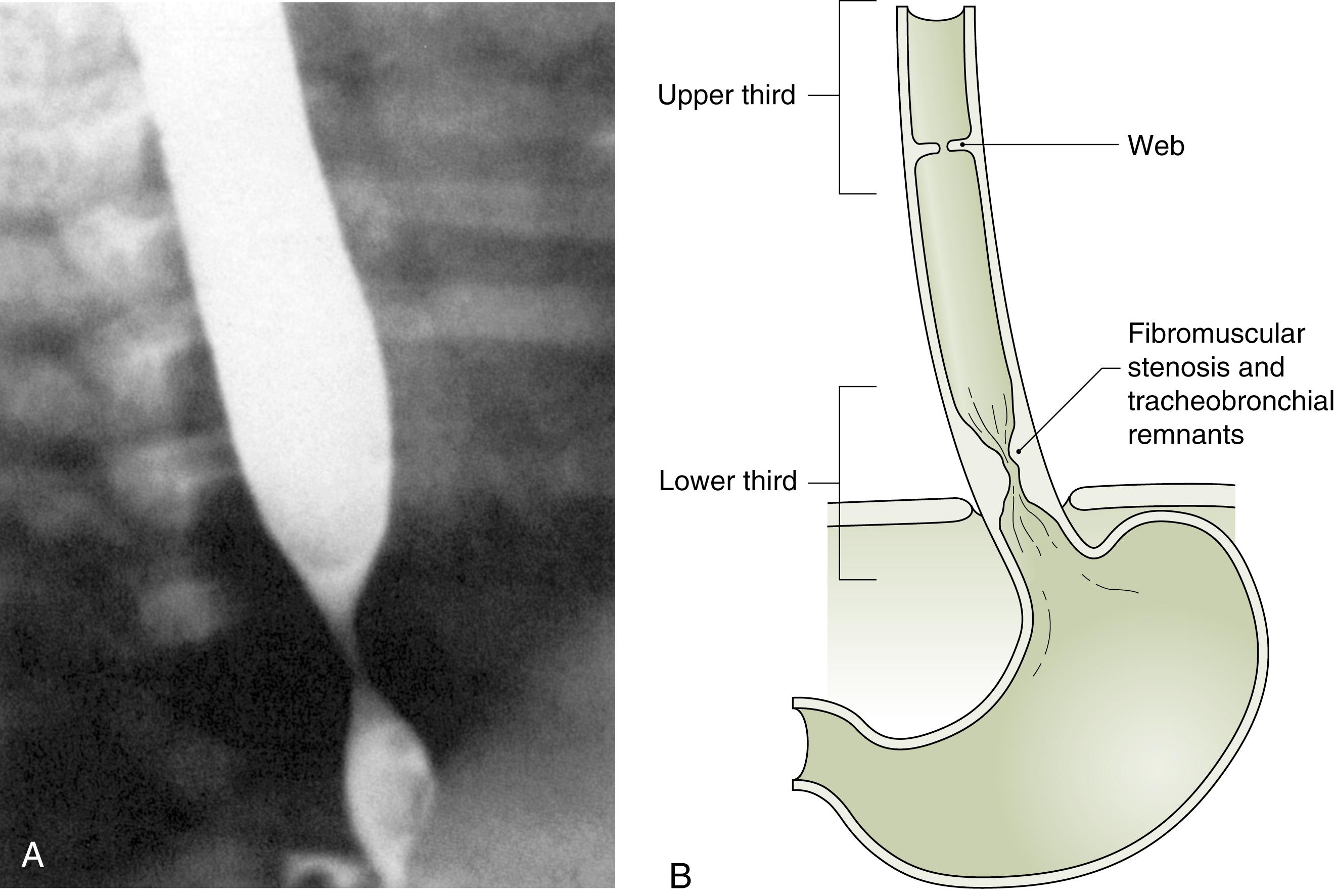Physical Address
304 North Cardinal St.
Dorchester Center, MA 02124
Congenital lesions of the esophagus fall into three categories: congenital esophageal stenosis, the variants of esophageal atresia and tracheoesophageal fistula, and laryngotracheoesophageal clefts.
Congenital esophageal stenosis presents in three variants: esophageal webs or diaphragms, fibromuscular stenosis, and stenosis due to cartilaginous tracheobronchial remnants. These lesions, collectively, are rare, occurring in 1 in 25,000 to 1 in 50,000 live births. Most often, congenital esophageal stenosis presents as an isolated finding, but in 15% to 30% of cases, this condition is associated with other congenital anomalies. Up to 8% of infants with esophageal atresia and tracheoesophageal fistula have an associated distal congenital esophageal stenosis, whereas 20% to 48% of children with congenital esophageal stenosis have esophageal atresia. Other associated anomalies include cardiac defects, intestinal atresias, imperforate anus, and chromosomal abnormalities.
Congenital esophageal stenosis may not manifest in the newborn period, because breast milk or formula passes through the stenotic area without difficulty. Symptoms often start at approximately 6 months of age, when semisolid and solid foods are introduced into the diet; however, the diagnosis is typically delayed. The infants then begin to regurgitate undigested foods and may develop recurrent respiratory infections due to aspiration. In 35% of unrecognized cases, the patients may present later with growth retardation. When these symptoms occur, esophagography is often undertaken, which reveals the stenotic area and may show dilation of the esophagus proximal to the stenosis. Esophageal diaphragms or webs reveal a thin layer of tissue causing stenosis compared with fibromuscular stenosis and cartilaginous remnants, which present a thicker and longer area of stenosis usually in the mid to distal esophagus ( Fig. 20.1 ). In a child with these radiologic findings and the appropriate clinical picture, the differential diagnosis would include achalasia and a stricture from gastroesophageal reflux disease. To make the distinction between these entities, additional work-up including endoscopy, manometrics, and 24-hour pH probe studies is useful. Recently, endoscopic ultrasound has been used to differentiate stenoses due to cartilaginous rests from those due to fibromuscular stenosis.

Therapy is dictated by the type of stenosis encountered. The thin proximal esophageal membrane or web can often be dilated at the time of endoscopy. On occasion, these membranes require partial resection with electrocautery or laser through the endoscope followed by dilation. The stenoses with cartilaginous remnants often require resection and primary anastomosis, as dilation is usually not effective in this type of stenosis. Fibromuscular stenosis can be dilated in most cases. A series from Japan used endoscopic ultrasound to differentiate fibromuscular stenosis from cartilaginous rests. Those with cartilaginous rests went on to surgery, and the children with fibromuscular stenosis were dilated. Ten of 13 children with fibromuscular stenosis were successfully dilated, and the remaining three required resection. Without the use of ultrasound, it is difficult to distinguish the difference predilation between fibromuscular stenoses and stenosis with cartilaginous remnants. A series of dilations should be attempted, and if dilation fails, the stenotic portion of the esophagus should be resected. In a series where all congenital esophageal stenoses were dilated, 10.6% resulted in perforation, all responding to conservative management. The exact location of the stenosis is often difficult to locate using only contrast studies. To find the stenotic area, it is helpful to place a Fogarty catheter past the stenosis, inflate the balloon, and pull back the catheter. Placing contrast in the esophagus will then verify the location of the stenosis. Intraoperatively, a lighted endoscope placed at the level of the stenosis aids in locating the stenosis, which is often impossible to locate accurately with palpation and inspection alone. The operative approach varies according to the level of the stenosis. If the stenotic area is in the midesophagus, the operative approach should be through a right thoracotomy, but if the stenosis is located in the distal esophagus, a left thoracotomy will provide the necessary exposure. The stenotic area of the esophagus is excised and a single-layer end-to-end anastomosis is performed. If the stenotic lesion is close to the gastroesophageal junction and resection may alter the antireflux mechanism, then a fundoplication should be added to the procedure.
Both dilation for webs and fibromuscular stenosis and resection for fibromuscular and cartilaginous remnant stenosis provide adequate relief of the stenosis. Overall, 33% of treated children with congenital esophageal stenosis continued to have symptoms, most commonly dysphagia. Compared with membranes or webs, fibromuscular stenosis required more frequent dilation over a longer period. Postoperative dilations following resection of esophageal stenosis were required to prevent anastomotic strictures and treat continued dysphagia. , ,
Become a Clinical Tree membership for Full access and enjoy Unlimited articles
If you are a member. Log in here